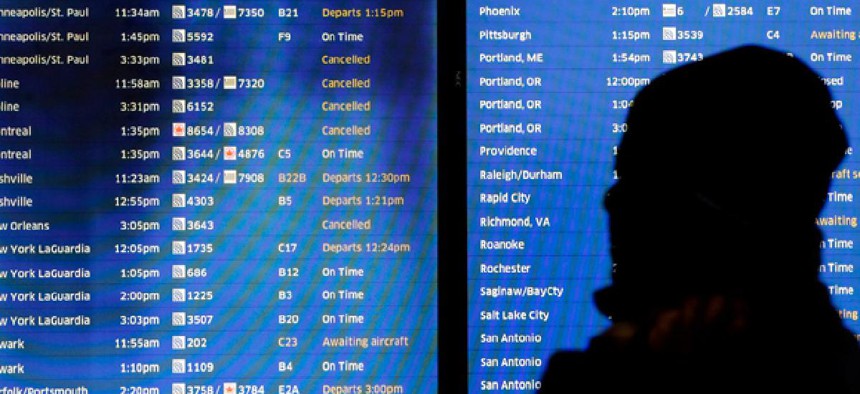Analysis: Living With the Nuances, Ironies, and Flexibility of Sequestration
Now that sequestration is here to stay, we all have to learn to live with it.
I don’t know about you, but I can’t wait for the Twitpic Sequester Olympics.
Brad Woodhouse, communications director for the Democratic National Committee, got the games going late Tuesday with a picture from Chicago’s O’Hare Airport and a long line of weary travelers. The Twitpic, shot by Jim Neal, a Democrat who ran for the Senate in North Carolina in 2008, was supposedly of a three-hour wait to pass through O’Hare’s customs checkpoint.
There’s no reason to doubt the authenticity of the Twitpic. But long lines at O’Hare’s customs checkpoint are nothing new, and sequestration can in no way be blamed—at least, not yet. Crain’s Chicago Business wrote on Dec. 24 how O’Hare customs checks were long, inefficient, and a threat to tourism. “While most passengers are processed in less than an hour, customs delays of two or three hours or more are increasingly common at O’Hare, even though international passenger arrivals are down more than 8 percent from a 2007 peak of nearly 5 million,” Crain’s wrote. “The problem is expected to get much worse next summer, when five new foreign carriers start serving O’Hare.”
What the Twitpic heralds, however, fills me with dread. I can see into Twitter’s future and espy raucous, roiling debates (the kind that would make Woodward and Sperling blush) over the accuracy of Twitpics of airport baggage lines, Customs ports of entry, border-crossing stations—any place where federal workers either are or aren’t. Behold the Twitpic Sequester Olympics, wherein part of our political debate will be consumed with pictures and commentary about how much of our nation does or does not resemble the DMV. How stirring.
Oh well, sequestration is here to stay. You could see that on President Obama’s face as he glumly settled in with his still-unformed Cabinet for the first time in the second term. Obama said the federal government would “manage it as best we can.” The cuts come to $85 billion in budget authority over two years. The Congressional Budget Office, by the way, estimates the actual reduction in outlays this year will be $42 billion.
Management is an open question now, because it is hard to know when the budget cuts will cause noticeable disruptions. Even Homeland Security Secretary Janet Napolitano appeared perplexed when, after telling a Politico breakfast on Monday that major airports were “already” experiencing sequestration-induced delays, specifics proved elusive.
“I want to say O’Hare, I want to say LAX [Los Angeles International], I want to say Atlanta [Hartsfield], but I’d have to check,” Napolitano said. “The New York airports got through OK, but that is going to be temporary.”
But those airports reported no serious delays—hence the Woodhouse Twitpic.
Beneath these early takes on sequestration is the intriguing question of flexibility. How much does the federal government have and can it, for example, shift resources to protect vital services and cannibalize less important tasks for the greater good? There appear to be two solid and accurate answers—the first one well-understood, the second less so.
On the question of the across-the-board nature of the discretionary cuts, there is no discretion. Agencies and departments must cut by the percentage assigned by the Office of Management and Budget. OMB calculates the cuts as 8 percent for defense and 5 percent for non-defense over the fiscal year. That translates to 13 percent and 9 percent, respectively, when compressed into the seven remaining months of the budget year. Those cuts are legally binding and must be made.
What about what remains? Isn’t there discretion over what sequestration’s supposed meat cleaver leaves behind? It cannot all be gristle.
OMB offers a valuable clue. In guidance sent to all agencies on Feb. 27, Danny Werfel, OMB controller, instructed “heightened scrutiny of certain types of activities funded from sequestered accounts.” Specifically, Werfel advised agencies to be careful in spending “post-sequestration” dollars on “hiring new personnel, issuing discretionary monetary awards to employees, (and) incurring obligations for new training, conferences, and travel.”
Reads like flexibility to me. Agencies can manage and prioritize. In fact, Werfel said all planning—before and after sequestration—“must be guided by the principle of protecting the agency’s mission to serve the public to the greatest extent practicable.” Apparently, the White House no longer considers taxpayer tours part of its mission.
Republicans have been needling the administration mercilessly on the point of flexibility, begging Obama to employ it. That, of course, accepts the premise that these spending cuts could harm public services and bite hard at home.
There’s another hilarious curiosity about the GOP’s sudden gushing enthusiasm for federal bureaucratic flexibility. May I rudely remind Republicans that congressional earmarks—an industry that grew exponentially under their stewardship of Congress—were justified (for public consumption, anyway) as an instrument to frustrate meddling federal bureaucrats who could not be trusted to manage taxpayer dollars.
In other words, Republicans trust themselves, but not bureaucrats, to spend tax dollars. And they trust bureaucrats, but not themselves, to cut spending. I’m glad we’ve got that cleared up.
One last point. Over the weekend, Obama began calling Republican senators in search of partners for a deficit-reduction deal that might include tax reform and serious reductions in entitlements such as Medicare and Medicaid. This is the “grand bargain” Holy Grail that has played, at times, more humorously in Washington than Monty Python in London. After losing the election, GOP leaders began to see sequestration as the best—and quite possibly only—mechanism to force Obama back into serious “grand bargain” conversations.








